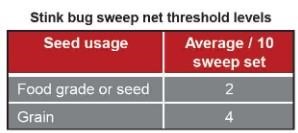By Kelley Tilmon and Andy Michel
There are many species of stink bugs that feed on soybean including brown marmorated stink bug (BMSB), green, red shouldered, and brown stink bugs. Stink bugs injure soybean in the latter half of the season after flowering by feeding on pods and seeds, resulting in lower yields and reductions in seed quality, the latter being a major concern when soybean is grown for seed or food grade purposes.

Sampling: Begin scouting for stink bugs when the soybean plant reaches the R2 stage (full bloom, when the plant has an open flower at one of the two upper-most nodes on the main stem). Stink bug feeding can cause economic loss from the R3 stage (pod set) to the R6 stage (full seed set). Using a sweep net, sample in at least 5 locations in smaller fields, more in larger fields. Stink bugs tend to be more numerous on field edges so sample hroughout the field for the overall
picture. At each location take a set of 10 sweeps, taking a step with each sweep of the vegetation. Count the number of stink bugs captured in your sweep net for each 10 sweep set. All pest stinkbug species, both adults and nymphs, should be counted together. Average your counts per set – thresholds range from an average of 2 to 4 stink bugs per 10-swep set based on intended use.
Source : osu.edu